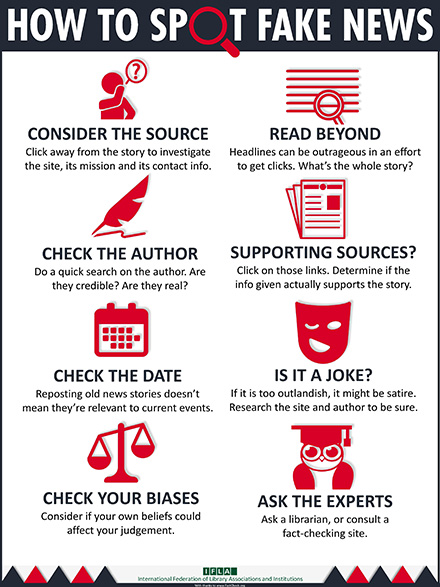

Consider the source: Click away from the story to investigate the site, its mission and its contact info.
Read beyond: Headlines can be outrageous in an effort to get clicks. What’s the whole story?
Check the author: Do a quick search on the author. Are they credible? Are they real?
Supporting sources? Click on those links. Determine if the info given actually supports the story.
Check the date: Reposting old news stories doesn’t mean they’re relevant to current events.
Is it a joke? If it is too outlandish, it might be satire. Research the site and author to be sure.
Check your biases: Consider if your own beliefs could affect your judgement.
Ask the experts: Ask a librarian, or consult a fact-checking site.

When to Use Quick Search:
On the left sidebar, you can "Refine Your Search" a number of different ways--including by publication date & scholarly/peer reviewed sources.
Good for: Overviews, news, and opinions on social issues.
Contains: Featured viewpoint reports, academic and magazine articles, infographics, and links to related web sites.
Good for: Controversial topics in social issues, environment, health, education, science, and technology.
Contains: Reports with information about all sides of an issue, including comments from experts in the field, charts and graphs, a pro-con feature, a chronology, a bibliography for additional research, and a list of advocacy organizations.
Dates covered: 1923-present.
Good for: Conducting academic research on all subjects.
Contains: Journal articles, streaming media, e-books and dissertations and theses.
Good for: Conducting academic research on all subjects.
Contains: Journal, magazine, and newspaper articles.
Good for: Searching the text of articles published in the Las Vegas Review-Journal.
Contains: Article text (no images).
Dates covered: 1996-present.
Good for: Finding regional news articles and broadcast television transcripts.
Contains: Regional newspapers and transcripts.
Good for: Finding current and recent news articles from major U.S. newspapers.
Contains: Articles from newspapers like the Los Angeles Times, Chicago Tribune, New York Times, and the Wall Street Journal.
Dates covered: 1980s-present.
Good for: Researching published news, legal, medical, patents, and business information.
Contains: News, legal, medical, and business information.
Good for: Finding New York Times articles.
Contains: Articles.
Dates covered: 1980-present. (Includes New York Times Book Review and New York Times Magazine from 1997 forward.)
Good for: Finding news articles from the Los Angeles Times.
Contains: Articles.
Dates covered: 1996-present.
Good for: Searching newspapers from ethnic, minority, and native communities in the United States.
Contains: Newspaper articles, editorials, and reviews.
Dates covered: 1959-present.
Good for: Finding newspaper articles about African American life and culture in Chicago.
Contains: Newspaper articles.
Dates covered: 1909-2010.
Good for: Finding newspaper articles about national and international news and events.
Contains: Newspaper pages.
Dates covered: 1851-2021.
Government information can be very useful when searching a wide variety of topics. One of the easiest ways is to go to Google! After you type in your keywords, then type in site:gov (example: air pollution site:.gov) to limit your search to only government-related resources. This will include federal, state, and local resources.
Good for: Researching social and political issues.
Contains: Think tank reports and documents.

